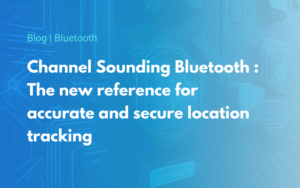
In 1999, Bluetooth was born, offering a standard for wireless communication using radio waves. Since then, this technology has continued to evolve, and has been rapidly integrated into many of our everyday devices. In 2010, with the release of version 4.0 of the Bluetooth Core Specification, Bluetooth Low Energy (BLE) made its appearance, featuring considerably reduced energy consumption.
Bluetooth Low Energy features
Bluetooth Low Energy, often abbreviated to BLE, is also known as Bluetooth Smart. The technology was originally developed by Nokia under the name Wibree before being adopted by the Bluetooth Special Interest Group (SIG). Its primary objective is to provide a wireless communication solution while minimising energy consumption, making it a preferred choice for the Internet of Things (IoT).
Key benefits of Bluetooth Low Energy
- Low power consumption: BLE consumes up to half the power of conventional Bluetooth, which means longer battery life.
- Transferring small amounts of data: Designed for periodic, low-volume data exchanges, BLE is ideal for applications that require light, short-range exchanges.
- Low cost: In addition to its low power consumption, BLE is relatively inexpensive to implement, making it an affordable solution for many devices.
BLE architecture and operation
BLE has different types of connections. An object connected in BLE can have up to 4 different functions:
- The “Broadcaster”: it can act as a server. Thus, its purpose is to regularly transmit data to a device, but it does not accept any incoming connection.
- “The Observer”: In a second step, the object can only listen to and interpret the data sent by a “broadcaster”. In this situation, the object cannot send connections to the server.
- The “Central”: often a smartphone or a tablet. It is an element that interacts in two different ways: either in advertising mode or in connected mode. He is then the leader and it is from him that the exchange of data starts.
- The “Peripheral”: it accepts connections from the exchange and sends data to it periodically. The aim of this system is to package data universally via the protocol so that it can be understood by other devices.

Advertising and connected mode
Bluetooth devices send packets to broadcast data: this is Advertising. These are 31-byte blocks that can contain sender-specific information. They are also used to allow other devices (usually scanners) to connect to them. For information, there are several types of Advertising packages allowing each one to realize different functionalities (used for Direct or Indirect Advertising with or without the possibility of connection).
In BLE two devices can establish a connection on a master/slave principle. This is connected mode. In this case, the GATT protocol is often used (acronym of “Generic ATTribute”) to transmit the data. This protocol defines how two BLE devices exchange data. It uses the concepts of “services and features” used to describe the information exchanged:
- A service may contain a collection of features
- A characteristic contains a description, a value and information to define the value.

Classical Bluetooth Vs Bluetooth Low Energy (BLE)
In reality, these two technologies are used for very different purposes. Classical Bluetooth is used to process, transfer and exchange many data without interruption (e.g. audio). However, it quickly consumes battery life and costs much more.
Bluetoothuses the same frequency range as Wi-Fi, but the resemblance ends there. Bluetooth and especially BLEconsumes less energy. However, the range and speed are much less important than for Wi-Fi.
BLE, on the other hand, is used for applications that do not require the exchange of large amounts of data and therefore retrieves relatively light information (such as time or temperature, for example). Offering a non-continuous connection, it can operate on battery power for several years at a lower cost than Bluetooth. -Find out more about the difference between Bluetooth and Bluetooth Low Energy-.

Discover the wide range of BLE beacons
renowned for their sturdiness and high autonomy
BLE frequency and channels
BLE uses UHF radio waves, operating in the 2.4 GHz band, similar to Wi-Fi. This frequency is divided into 40 channels, each 2 MHz apart. Some channels are dedicated to advertising, while others are reserved for connections.
BLE security and reliability
BLE benefits from several levels of security, making it suitable for environments requiring secure communications. What’s more, its robustness and adoption by the major technology players guarantee universal compatibility and sustainable adoption over time.
Bluetooth 6.0
Bluetooth version 6.0, launched in 2024, marks a significant advance in wireless communications. It introduces improvements in speed and range, enabling data transfers up to twice as fast as Bluetooth 5.0, while maintaining low energy consumption. This version is designed to meet the growing demands of IoT applications, particularly in dense environments where many devices are connected simultaneously. Bluetooth 6.0 also improves interference management, providing a more stable and reliable connection.
Translated with DeepL.com (free version)
Why choose Bluetooth Low Energy for the IoT?
Bluetooth Low Energy is perfectly suited to industrial and Internet of Things applications. It enables crucial information to be exchanged, such as temperature, humidity or movement data, while optimising battery life. It is a low-cost, low-power protocol designed to meet the needs of today’s connected devices.


